Click the above 【Car Cloud】 to follow and see more past content.
As an emerging technology, the Internet of Vehicles involves various aspects of the industrial chain, requiring cooperation among automobile manufacturers, chip manufacturers, communication operators, and content service providers. This not only breaks down the barriers of the traditional automobile manufacturing industry but also presents opportunities and challenges for communication operators, the internet, and OTT.
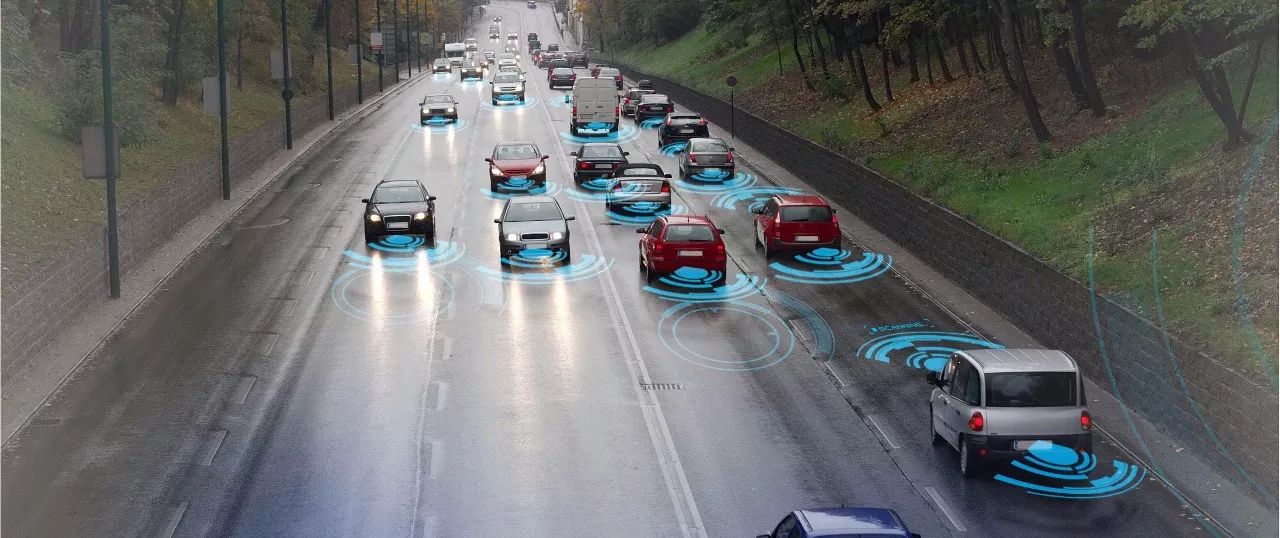
In October, China Unicom published the “China Unicom Vehicle Networking White Paper (2017)”, which describes the business vision for the development of the Internet of Vehicles based on the basic concepts and characteristics of the technology, defining the basic system architecture of the Internet of Vehicles, and exploring the technical roadmap and key technologies for the evolution of the Internet of Vehicles from the operator’s perspective.This article is excerpted from the third part of the white paper, “Unicom’s Vehicle Networking Evolution and Deployment Strategy”. To obtain the full text of the white paper, you can add the personal WeChat account of Cheyun Jun (cheyunjun3) to request it.

1 Internet of Vehicles System Architecture
To meet the business needs of the Internet of Vehicles, the future network will adopt a unified architecture of “terminal – network – platform – application”, creating a cloud-network collaborative integrated network of “multi-mode communication + vehicle-road collaboration + vehicle-cloud synchronization”, as shown in Figure 1.
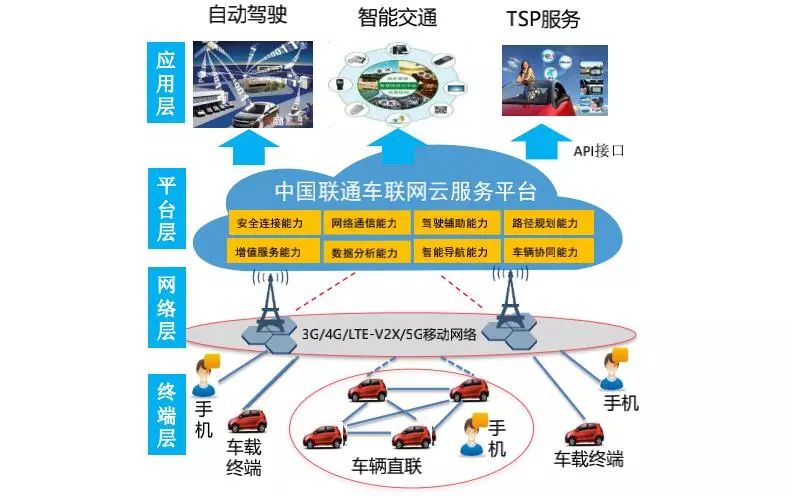
▲Figure 1: Cloud-Network Collaborative Integrated Network Architecture
(1) Three-Dimensional Communication Network
The future development of the Internet of Vehicles will inevitably rely on a three-dimensional communication network architecture, achieving multi-mode access, vehicle-to-vehicle direct communication, and supporting various low-latency and high-reliability services for vehicle communication through horizontal and vertical means. Horizontally, 3G/4G/5G networks will coexist, selecting different networks and technologies based on different service requirements (e.g., Telematics services, V2X services) to achieve multi-mode communication. Vertically, seamless communication between vehicles will be realized; with network coverage, vehicle-to-vehicle communication can be achieved through base stations, and in the absence of network coverage, direct communication can occur through V2V. The network will enable roadside facility information feedback and management, facilitating the rapid, flexible, and low-cost deployment of RSUs (Road Side Units), achieving data and service diversion, reducing network latency, avoiding resource conflicts, and ensuring data and service feedback. To enhance low-latency and high-reliability services based on base station communication, fiber transmission pipelines will be considered along highways, introducing edge cloud computing to provide IT service environments and cloud computing capabilities close to mobile users, and decentralizing service storage and distribution capabilities to the user side (e.g., base stations) to reduce network transmission latency.
(2) Cloud-Network Collaborative Platform
Building a collaborative interconnection cloud platform for the Internet of Vehicles to achieve interoperability. Functionally, the cloud platform for the Internet of Vehicles has network management capabilities, including service management and connection management, and features a general business analysis component for the Internet of Vehicles; it achieves vehicle-to-vehicle collaboration and vehicle-cloud collaboration. Additionally, it has network openness capabilities, such as conducting big data analysis to expand new business channels or allowing third-party companies to access the network for business customization. The unified cloud platform is a crucial component of the future Internet of Vehicles, requiring the following characteristics, as shown in Figure 2: as a bridge connecting the network and application services, the cloud platform should first support common platform construction, possessing certain generality, flexibility, security, development capability, and stability; secondly, it must ensure the experience of various users, possessing network openness capabilities to achieve interoperability between networks, supporting ubiquitous access, and ensuring users are always online and receive real-time responses through modularization. Finally, it should support multiple scenarios, such as proactive safety, route planning, data sharing, and collaborative perception.
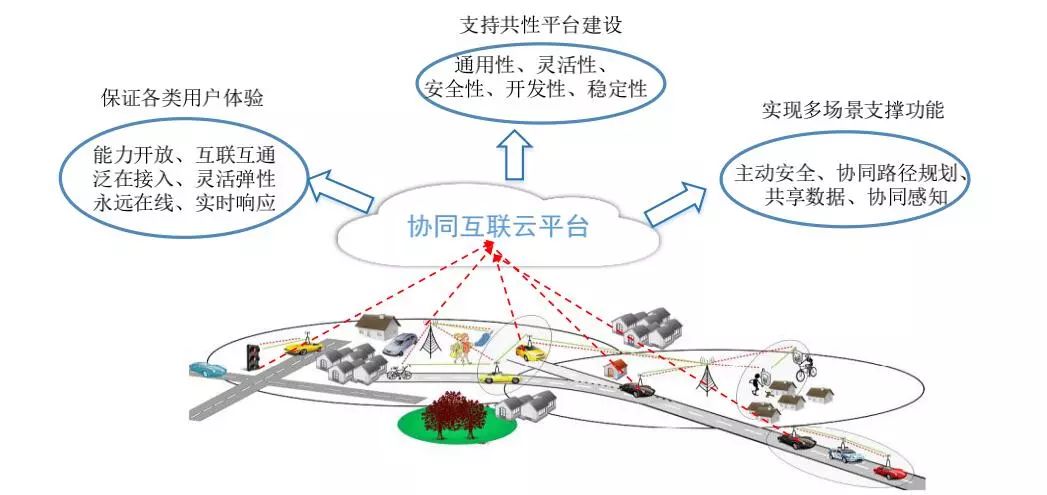
▲Figure 2: Core Characteristics of the Collaborative Interconnection Cloud Platform for the Internet of Vehicles
(3) Comprehensive and Diverse Services
The future business of the Internet of Vehicles will evolve toward a comprehensive and diverse direction, based on the basic route of “Telematics – Intelligent Networking – Intelligent Transportation”. Existing Telematics services mainly provide remote information services, such as intelligent navigation, video downloads, and fault diagnosis. With the completion of the LTE-V2X standardization, assisted driving is gradually permeating people’s lives, including proactive safety (collision avoidance at intersections, forward braking reminders, overtaking reminders, etc.), traffic efficiency (traffic light speed guidance, traffic information, and route planning, etc.), and information services (car-sharing, point-of-interest reminders, charging station guidance, etc.). In the 5G phase, the Internet of Vehicles will realize automated driving functions, including advanced driving, platooning, sensor information sharing, and offline driving. In the era of big data, targeting the massive data of the Internet of Vehicles, integrating communication network big data, personal user big data, and intelligent vehicle and intelligent transportation data will provide big data analysis and promotion services, creating a big data ecosystem based on the internet and automobiles.
(4) The Role of Operators in the Industry
In the traditional Internet of Vehicles industrial chain, service providers include not only car manufacturers and 4S shops but also internet application providers, software and hardware providers, automotive remote service providers, and telecommunications operators, as shown in Figure 3-3, where the direct service providers to users are 4S shops, automotive aftermarket equipment providers, and telecommunications operators, while other industries provide indirect services. In the future, the industrial chain will present an interwoven pattern across various industries, with capital flow exhibiting multi-directional and rapid characteristics.
For telecommunications operators, the landscape of the Internet of Vehicles industry is undergoing transformation, and their roles are changing. Traditional operators mainly provide communication pipelines, maintain network stability and security, and generate revenue primarily through traffic operations. As the landscape of the Internet of Vehicles changes, operators are exploring new service roles, transitioning to building Internet of Vehicles platforms and conducting Internet of Vehicles business operations to create new revenue opportunities. Currently, the exploration of transformation mainly includes three methods:
(1) Building an Internet of Vehicles business operation platform. For example: China Unicom provides a Telemetics Service Support Platform (TSSP) for automotive information services;
(2) Providing Internet of Vehicles network solutions to automotive manufacturers based on network experience. For example: Verizon offers a complete network connectivity solution to automotive manufacturers using 4G networks and cloud computing platforms;
(3) Bundling sales of software and hardware related to the Internet of Vehicles based on traffic advantages. For example: AT&T focuses on managing traffic for the Internet of Vehicles and bundling sales of related software and hardware.
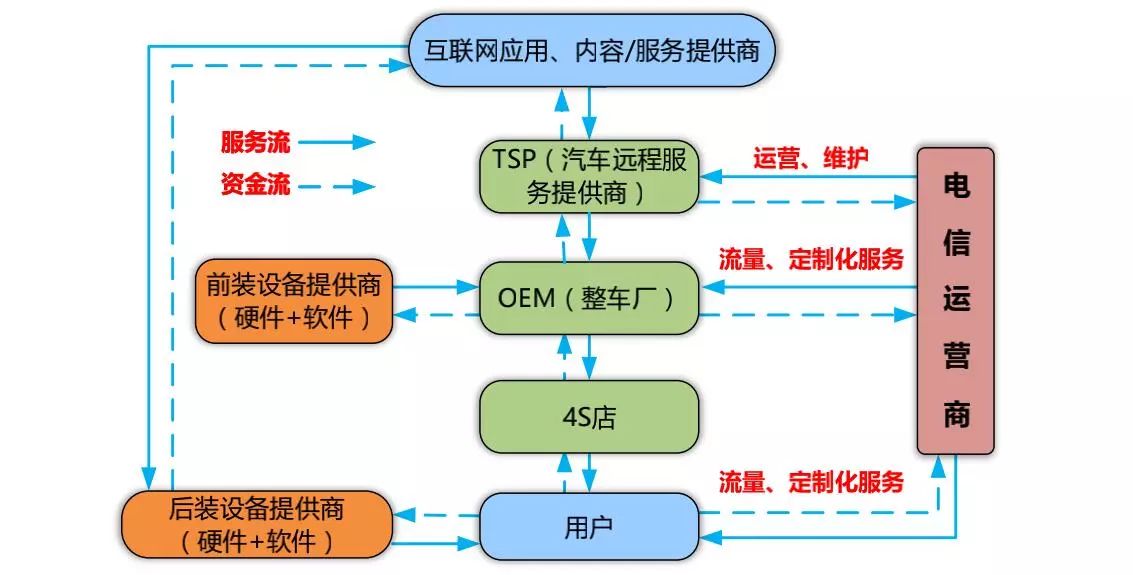
▲Figure 3: Schematic Diagram of the Internet of Vehicles Industrial Chain

2 Evolution of the Internet of Vehicles Network
2.1 Technology Roadmap of the Internet of Vehicles
The evolution route of V2X technology is shown in Figure 3-4. Currently, the Internet of Vehicles network is primarily based on LTE-V2X, which includes two modes of communication: Uu interface communication and PC5 interface communication, functionally meeting the 27 application scenarios proposed by 3GPP (3GPP TR 22.885), including proactive safety, traffic efficiency, and infotainment. The goal of LTE-eV2X is to further improve the reliability, data rate, and latency performance of the V2X direct communication mode while maintaining compatibility with LTE-V2X, partially meeting the demands for more advanced V2X services. The relevant technologies mainly focus on enhancing PC5, adopting the same resource pool design concept and resource allocation format as LTE-V2X, allowing coexistence with LTE-V2X users without resource collision interference. The enhancement technologies in LTE-V2X mainly include carrier aggregation, high-order modulation, transmission diversity, as well as low-latency research and resource pool sharing research. In the future, the Internet of Vehicles will exist in a state of coexistence of multiple technologies, including 5G-V2X and LTE-eV2X, primarily achieving 25 application scenarios related to automated driving (3GPP TR 22.886), including platooning, advanced driving, sensor information interaction, and remote driving.
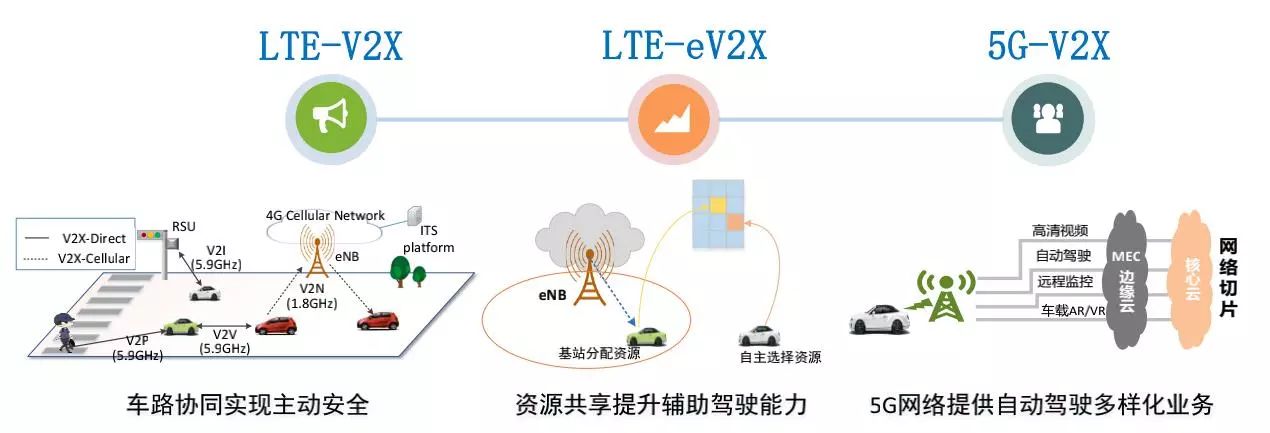
▲Figure 4: V2X Network Evolution
2.2 Key Technologies of the Internet of Vehicles
2.2.1 C-V2X Communication
In February 2015, 3GPPSA1 officially launched the LTE-V2X business demand research project, marking the beginning of the standardization of LTE-V2X technology in various 3GPP groups, and completed the first phase of V2X standard formulation in March 2017.
C-V2X can be classified into four types based on business models, including:
V2N (vehicle-to-network) communication, including dynamic map downloads, automated driving-related route planning, remote control, etc.;
V2V (vehicle-to-vehicle) communication, including core safety applications such as collision avoidance and congestion avoidance, which are not limited by network coverage;
V2P (vehicle-to-pedestrian) communication, communication between vehicles and people, primarily used for pedestrian safety;
V2I (vehicle-to-infrastructure) communication, used for communication between vehicles and road facilities, providing or receiving local road traffic information.
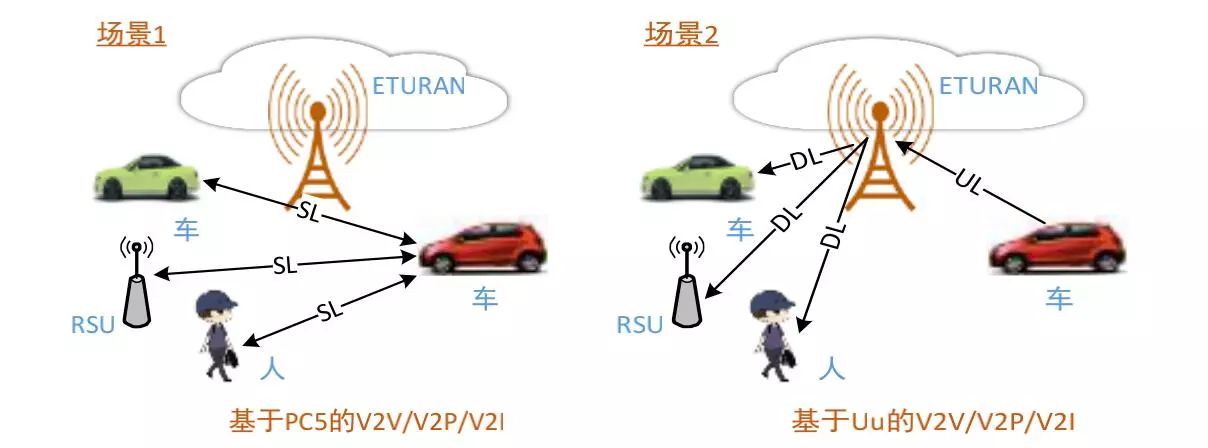
▲Figure 5: Classification of LTE-V2X
Simultaneously, C-V2X can be divided into two communication methods based on different interfaces: V2X-Direct and V2X-Cellular, as shown in Figure 3-5. V2X-Direct communicates through the PC5 interface, utilizing dedicated frequency bands for vehicle networking (e.g., 5.9GHz), enabling direct communication between vehicles, roads, and people, with low latency and high mobility support, but requiring good resource allocation and congestion control algorithms. V2X-Cellular, on the other hand, forwards through the cellular network Uu interface, using cellular frequency bands (e.g., 1.8GHz). The specific comparison between PC5 and Uu interfaces is shown in the table.
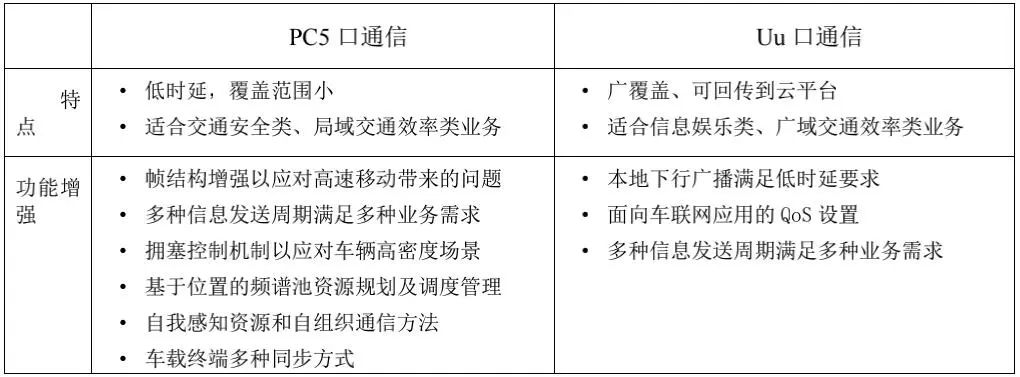
2.2.2 Edge Cloud
The main characteristics of driving safety-related services in the Internet of Vehicles are low latency and high reliability. In terms of latency requirements, assisted driving requires 20-100ms, while automated driving can require latencies as low as 3ms. Edge cloud is one of the enabling technologies for achieving low-latency services in existing mobile networks.
Multi-access Edge Computing (MEC) is an open platform that integrates network, computing, storage, and application core capabilities at the network edge close to people, objects, or data sources, providing edge intelligent services nearby to meet key industry digitalization needs in agile connectivity, real-time services, data optimization, application intelligence, and security and privacy protection. Generally, for the Internet of Vehicles scenario, MEC systems can be constructed in two ways: one is to build an edge cloud system at the base station side using several general-purpose servers to complete local traffic offloading and embed Internet of Vehicles-related applications. The other is to provide certain computing capabilities within the base station. Edge cloud provides localized cloud services and can connect to public clouds or private clouds within other networks to achieve hybrid cloud services.
Edge cloud computing can provide low-latency services for mobile terminals by deploying the local cloud platform at the base station side. As shown in Figure 3-6, through LTE cellular networks and the MEC platform for the Internet of Vehicles, local computing can send warnings and driving information to the onboard OBU in emergencies, reducing vehicle-to-vehicle latency to under 20ms compared to existing network latencies, significantly decreasing the owner’s reaction time. Additionally, the MEC platform can achieve path optimization analysis, driving and parking guidance, safety assistance information push, and regional traffic service guidance.
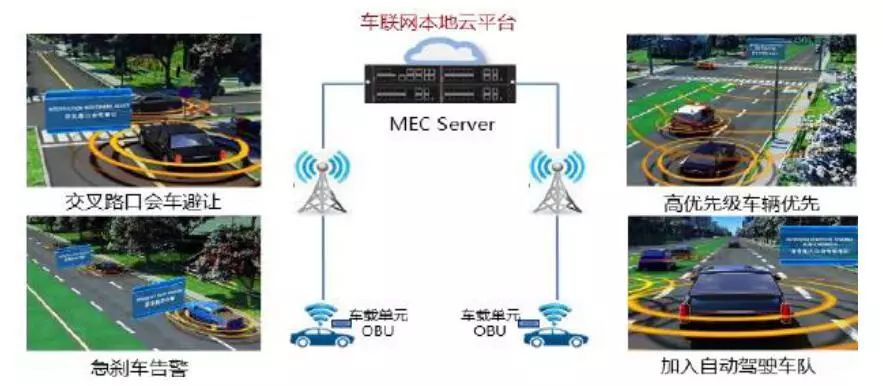
▲Figure 6: Implementing Internet of Vehicles Applications Based on MEC Platform
2.2.3 Network Capability Openness
As traditional communication service providers, operators are striving to transform their roles in new industrial collaborations to increase new profit revenue points, and network capability openness is one of the significant methods. The openness of 5G network capabilities will have a richer connotation; in addition to the internal information, QOS control, network monitoring capabilities, and basic service capabilities defined by 4G networks, the introduction of network virtualization, SDN technology, and big data analysis capabilities will provide 5G networks with a richer set of open network capabilities, such as the orchestration and management of network slicing.
The openness of network capabilities should be combined with specific business scenarios and comprehensively consider the differences in system architecture and business logic of third-party application platforms to achieve simple and user-friendly openness. Moreover, network capability openness must possess sufficient flexibility, allowing continuous opening of network capabilities to third-party applications as network functions further enrich without requiring complex modifications to third-party platforms and the network system itself. Network capability openness mainly includes: (1) opening of network and user information, (2) opening of wireless services and network resources, (3) opening of network computing resources.
In the new industrial model, it is imperative for operators to achieve network capability openness, encompassing business domains, platform domains, and network domains, as shown in Figure 7.
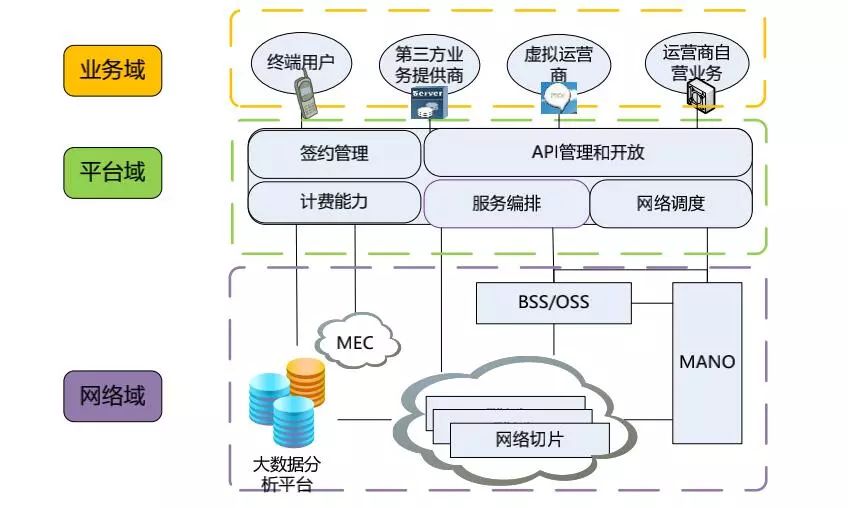
▲Figure 7: Vision Diagram of the Three-Domain Architecture for Network Capability Openness
The network domain includes the operator’s BSS/OSS, MANO, network slicing, network element entities, MEC, big data analysis platforms, and other network elements. Among them, the combination of BSS/OSS and MANO capabilities achieves unified orchestration and management of network slicing, as well as capability openness to the platform domain. Network slicing can support different Internet of Vehicles business needs, achieving different network configurations in various application scenarios. Network element entities realize specific network control capabilities, monitoring capabilities, and openness of network information and basic service capabilities. The big data analysis platform performs big data analysis on network basic data and reports the analysis results to the platform domain for external openness.
The platform domain serves as the brain and core for achieving network capability openness, acting as a bridge connecting internal network capabilities and external business demands, and is crucial for realizing network intelligence. In the Internet of Vehicles system, the platform domain not only possesses network management capabilities, implementing connection management and terminal management downwards, but also business management upwards. It allows third-party applications to access, enabling virtual operation management of Internet of Vehicles businesses; thus, it requires management of contracts with third-party businesses, API openness for business domains, billing functions, and orchestration and scheduling capabilities for network domains.
The business domain includes all individuals and enterprises that can interact with the network in the Internet of Vehicles, such as third-party service providers, virtual operators, end users, or the operator’s self-operated businesses. The business domain can input demand information for network capabilities to the platform domain and receive network capabilities provided by the platform domain, as well as provide capability information demanded by the network domain to the platform domain, achieving reverse capability openness.
2.2.4 Information Security of the Internet of Vehicles
As an important application of low-latency, high-reliability communication, the information security issues of the Internet of Vehicles are also receiving attention. As the application scope of the Internet of Vehicles continues to expand, security attacks are correspondingly increasing. Under the basic network architecture of the Internet of Vehicles, which includes “end-pipe-cloud”, every link is a key point for information security protection. The industrial chain of the Internet of Vehicles is long and involves terminal devices, communication devices, and cloud management and service platforms, with involved manufacturers including component suppliers, equipment manufacturers, complete vehicle manufacturers, software and hardware technology providers, communication service providers, and information service providers, covering control security, data security, functional security, and various other aspects. The protection measures for Internet of Vehicles security are numerous, and network security issues are complex, with vulnerable areas mainly including:
End:Information entertainment systems, T-box, CAN network, keys; apps on mobile phones and watches; OBD devices connected to the CAN network, etc.;
Pipe:Including communications from the vehicle machine, T-box to the backend, communications from apps to the backend, etc.; among which, V2X is a key technology for Internet of Vehicles communication, lacking corresponding mechanisms for detecting, isolating, and punishing untrusted nodes;
Cloud: Cloud servers where the TSP backend is located, etc.;
In addressing the network security strategies for the Internet of Vehicles, different security protection measures should be taken for different parts, as shown in Figure 8:
On-board intelligent terminals:In addition to implementing encryption measures on hardware, such as chip protection and hardware encryption, activate security monitoring and analysis for Internet of Vehicles terminals, enhancing application encryption and secure boot for terminal applications.
Communication security:Enhance access control, implement domain management, manage the network by domains, isolate control domains from information service domains, and manage data by domains to reduce attack risks; strengthen the functionality of network slices, conduct anomaly traffic detection on the network side, and enhance the network security protection capabilities of the Internet of Vehicles; strengthen identity authentication and key management, and implement certificate-based private communication encryption.
Cloud service platform:Use existing network technologies for security reinforcement, deploying firewalls, intrusion detection systems, and other security devices; establish a user credential management system for the Internet of Vehicles, verifying the identity of vehicles, mobile terminals, applications, etc., and enhancing key management; physically isolate different services, applying different levels of security protection measures based on the security level of the services; encrypt data and establish a core credential for centralized management of shared data, sharing threat intelligence and unsafe factors systematically.
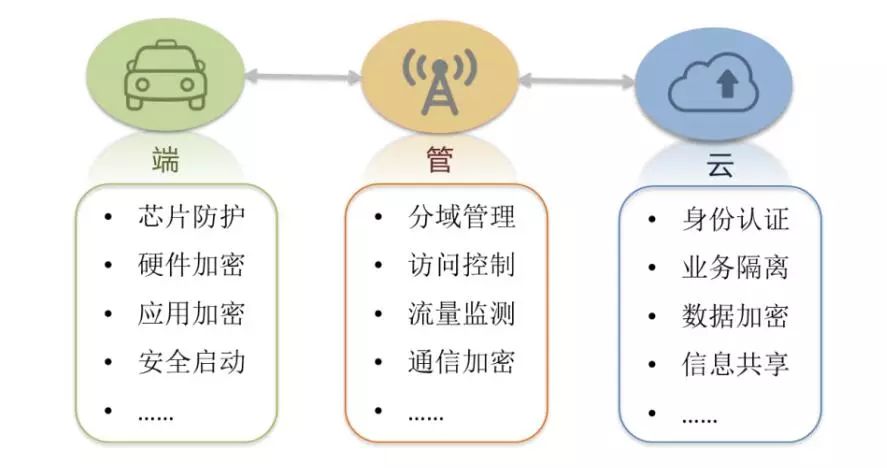
▲Figure 8: Information Security Protection Measures for the Internet of Vehicles
2.2.5 High-Precision Positioning
Location information is a crucial reference for providing services in the Internet of Vehicles; the more accurate the location information, the higher the reliability of the Internet of Vehicles services. Therefore, research on high-precision positioning is one of the key technologies for realizing Internet of Vehicles services.
In outdoor scenarios, commonly used positioning technologies include GPS, BeiDou, Assisted GPS (A-GPS), and positioning based on wireless communication cellular networks, such as Cell-ID technology and Enhanced Cell ID (ECID). Among them, the BeiDou Navigation Satellite System is China’s satellite positioning system with independent intellectual property rights, aiming to form a comprehensive national satellite navigation application industry support, promotion, and guarantee system, promoting the widespread application of satellite navigation in various sectors of the national economy and society. Positioning technology in indoor scenarios is more complex; to meet indoor positioning performance requirements, recent years have seen domestic and foreign scholars and research institutions researching the use of WLAN, Radio Frequency Identification (RFID), Ultra Wide Band (UWB), Bluetooth, and other wireless networks to achieve positioning technology for indoor mobile terminals, with positioning accuracy reaching the meter level, and even centimeter-level accuracy using UWB technology.
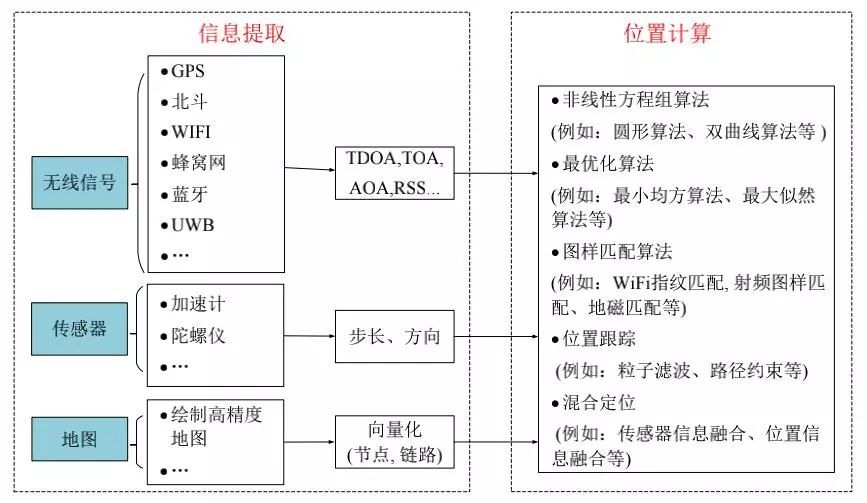
▲Figure 9: Schematic Diagram of Wireless Positioning System
The wireless positioning system mainly consists of two parts, as shown in Figure 9, including information extraction and location calculation. The functions of each part are as follows:
Information extraction:Objects that can be used for positioning include wireless signals (e.g., GPS, BeiDou, WiFi, cellular networks, etc.), sensors (e.g., accelerometers, gyroscopes, etc.), and map information, with different parameters extracted for positioning from each object. For wireless signals, the distance information between transceivers needs to be obtained by estimating the parameters of the wireless channel link between them, which includes Received Signal Strength (RSS), Time of Arrival (TOA), Time Difference of Arrival (TDOA), and Angle of Arrival (AOA). The actual received wireless signals are affected by non-line-of-sight transmission, multipath effects, and shadow effects; thus, even accurately estimating channel parameter information makes it difficult to obtain the exact straight-line distance between transceivers. Sensors provide information on the movement direction and step length of the positioning target. Map information is usually obtained by drawing high-precision maps, acquiring vectorized parameters to constrain or optimize the positioning target. The above parameters are prerequisites for the next step of location estimation.
Location calculation:The positioning algorithm is a key factor influencing the performance of the entire positioning system, requiring the algorithm to have good accuracy and the system to have low complexity and latency. The balance between accuracy and complexity is an important consideration in the development of positioning systems. Depending on the different parameters extracted, various positioning algorithms can be used. For example, based on parameters extracted from wireless signals, nonlinear equation group algorithms, optimization algorithms, or pattern matching algorithms can be employed. Meanwhile, using sensor information and map information, positioning tracking algorithms, including particle filtering and path constraint, can be applied. Additionally, high-precision positioning systems typically utilize hybrid positioning algorithms that fuse multiple sources of information.

3 Deployment of the Internet of Vehicles Network
3.1 Deployment Plan for the Internet of Vehicles Network
Based on LTE-V2X, the architecture of the Internet of Vehicles network is shown in Figure 10, which is an enhancement and improvement based on the cellular network architecture, involving key network elements and their functions as follows:
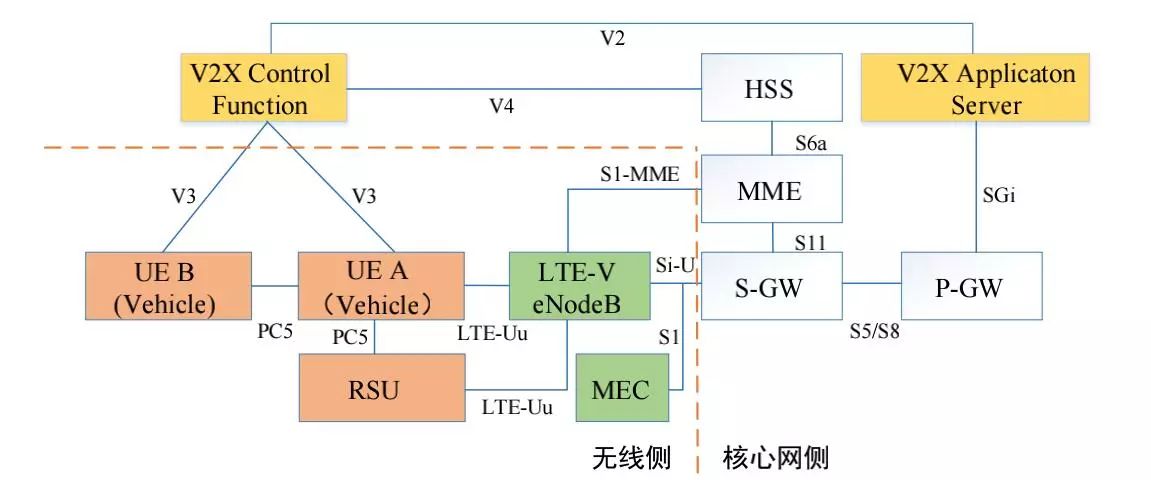
▲Figure 10: Internet of Vehicles Network Architecture
V2X Application Server:Core network logical unit, responsible for receiving and processing UE data, as well as configuring and sending broadcast information. It is also the interface for inter-network communication between operators.
V2X Control Unit:Logical control unit on the core network side, providing parameters for V2X communication.
LTE-V Base Station:Wireless side entity unit, responsible for forwarding data for Uu interface communication, implementing resource allocation in PC5 interface communication mode 3, and modifying pre-configuration information in mode 4.
Road Side Unit (RSU):Terminal entity unit, divided into terminal-type RSUs and base station-type RSUs, both capable of sending and receiving V2X data.
Onboard Terminal:Terminal entity unit, responsible for sending and receiving V2X data, implementing resource selection in PC5 communication mode 4.
MEC Server:Provides low-latency services based on Uu interface, localizing processing of V2X data. In intersection scenarios (e.g., vehicle speed guidance, traffic light control), considering limited resources in base station machine rooms, MEC functionality may be integrated at nearby base stations/RSUs for local data collection and edge computing; in industrial/enterprise parks, MEC edge servers can be deployed at nearby station rooms/integrated access rooms for real-time monitoring and scheduling of vehicles; along highways and other road lines, considering wide coverage, MEC edge servers need to be distributed along highways, but currently, due to the immaturity of MEC mobility management and resource migration plans in switching scenarios, this scenario can be promoted after the commercial deployment of 5G networks (continuous coverage along highways), and issues such as billing and QoS can be resolved subsequently.
3.2 Ideas for Building the Internet of Vehicles Network
The Internet of Vehicles is an essential component of smart cities and intelligent transportation. China Unicom’s Internet of Vehicles will rely on actual technological development to create a multi-dimensional three-dimensional network, supporting and serving the diversification of Internet of Vehicles businesses, focusing on key areas for deployment, accelerating the maturity of LTE-V technology, and exploring a smooth transition to 5G-V2X development.
The preliminary deployment plan and timetable are shown in Figure 3-11, which can be divided into four stages:
The first stage (2017-2018) focuses on building open laboratories, widely conducting industry exchanges and cooperation, constructing Internet of Vehicles experimental bases, and demonstrating typical scene businesses;
The second stage (2019) involves network verification of LTE-V2X, while conducting pre-commercial deployment of assisted driving services based on LTE-V2X, including proactive safety, traffic efficiency, and infotainment services;
The third stage (2020-2021) aims to achieve large-scale promotion of assisted driving services while conducting pilot deployments of Internet of Vehicles services based on 5G-V2X, laying the groundwork for automated driving;
The fourth stage (2022-) involves conducting 5G-V2X automated driving experiments and pilot promotions.
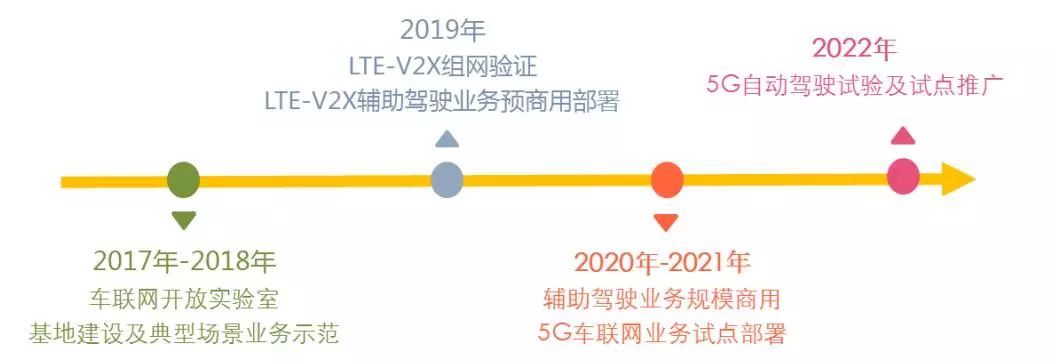
▲Figure 11: Timeline for Promoting the Construction of the Internet of Vehicles
 Car Cloud Recommendation
Car Cloud Recommendation



